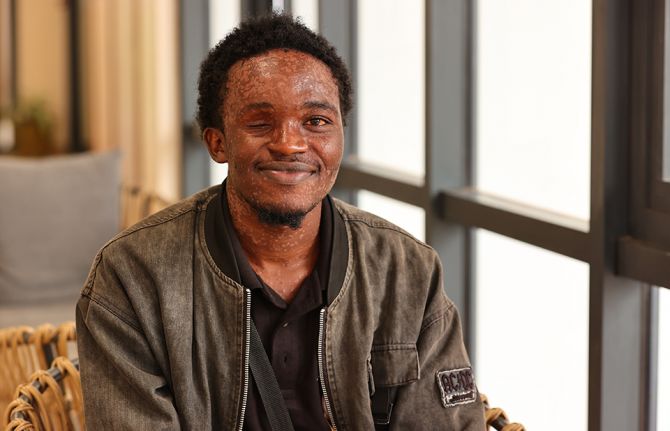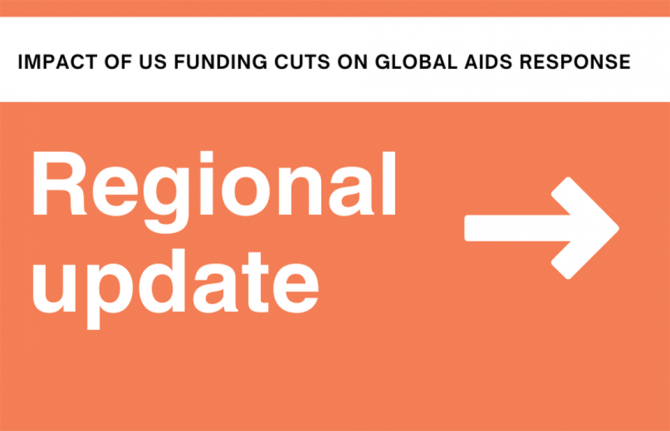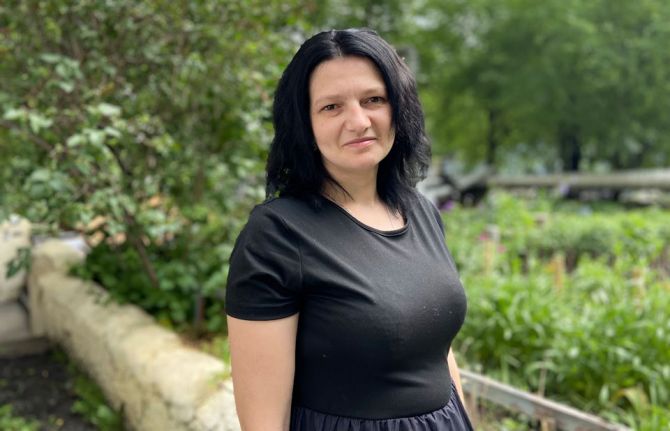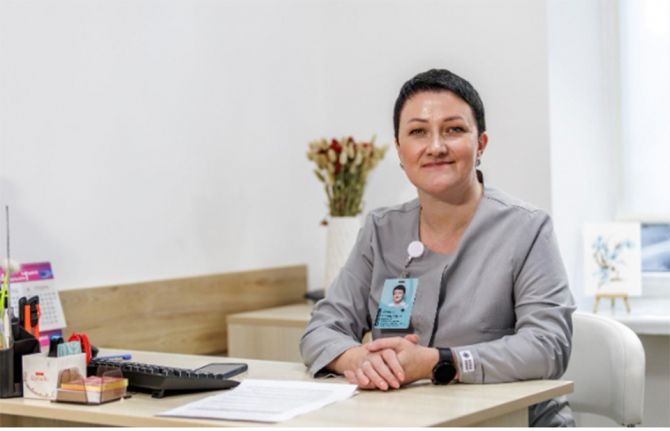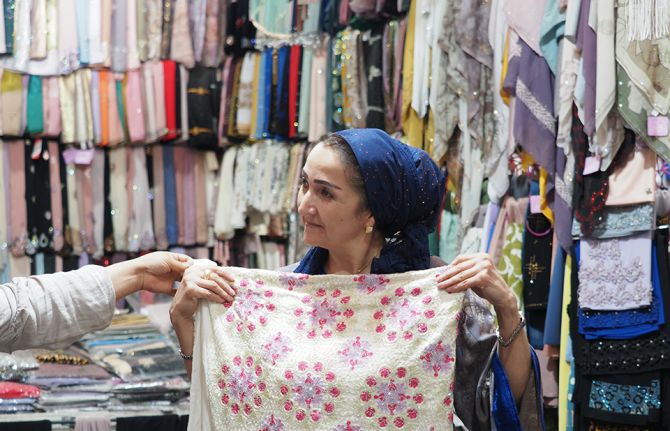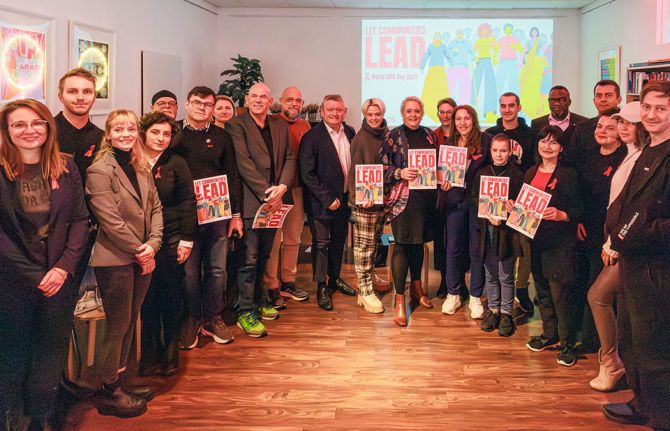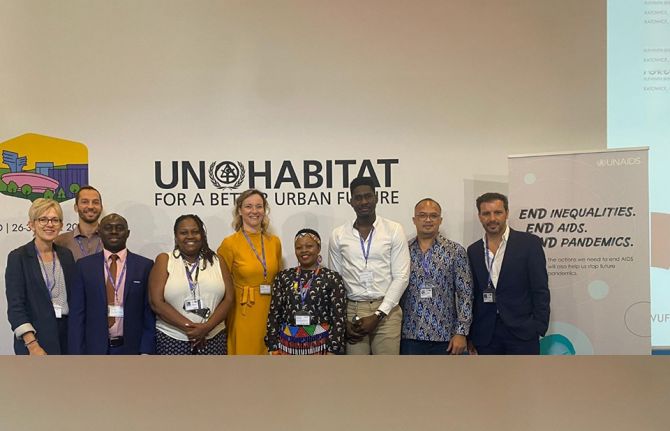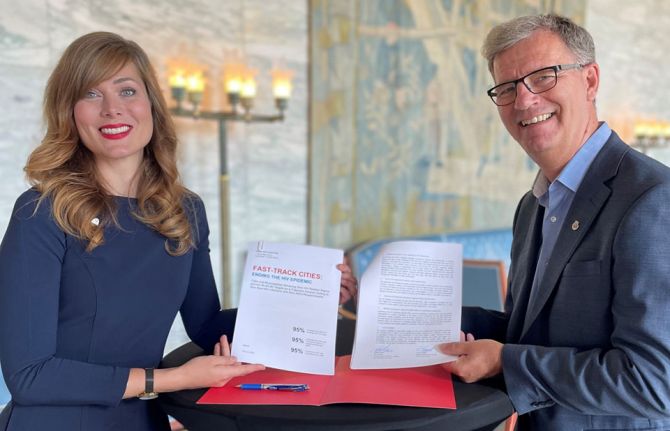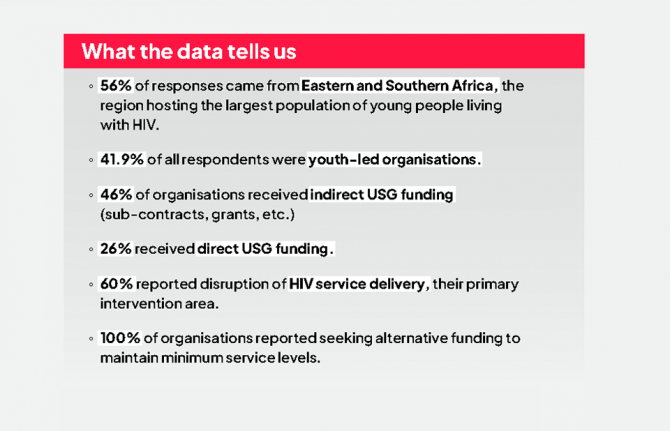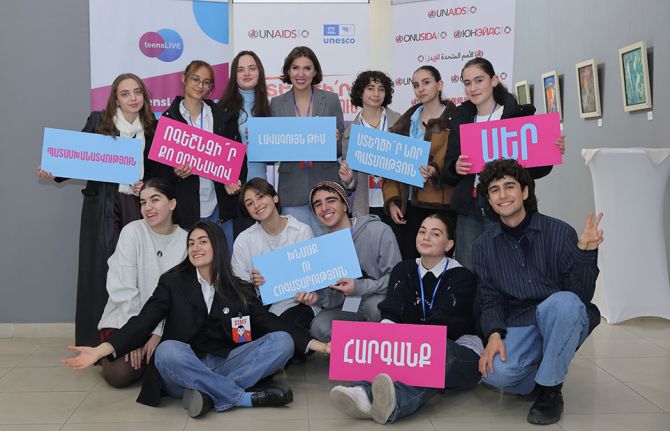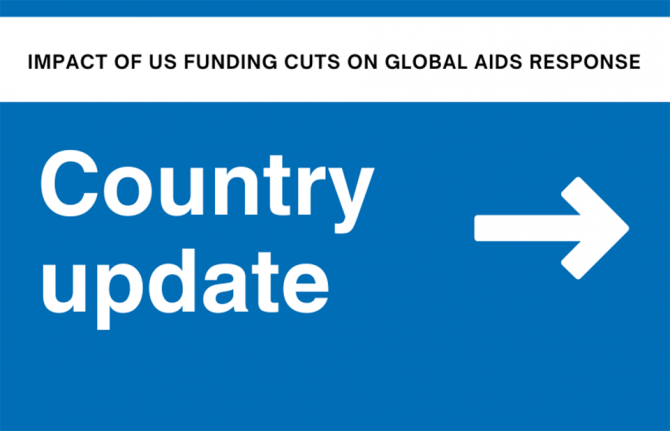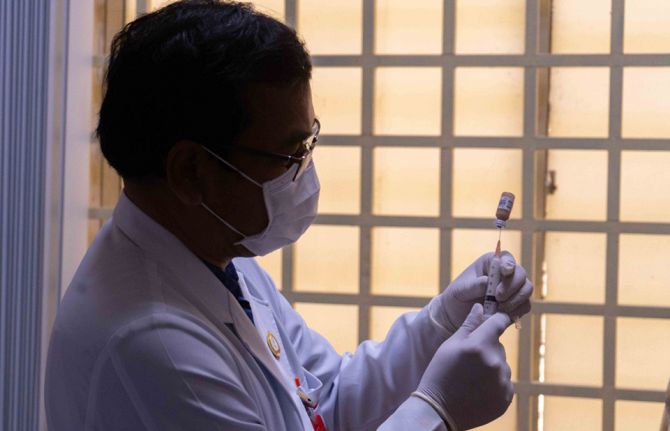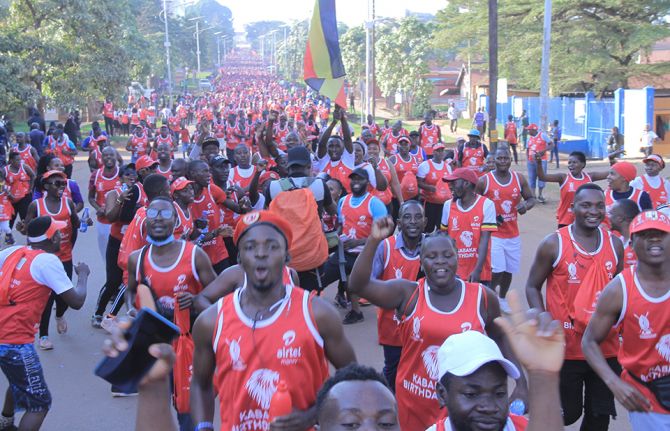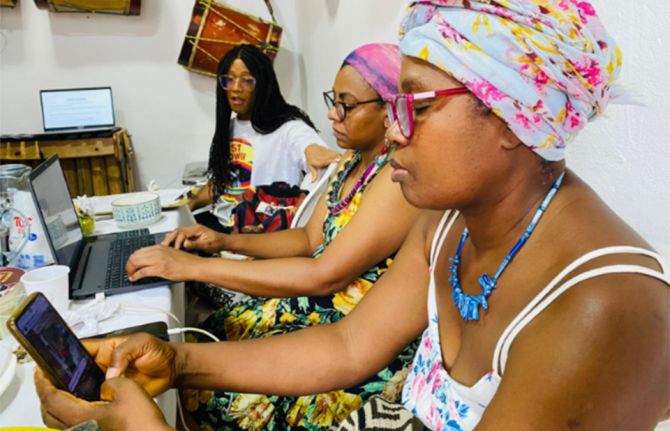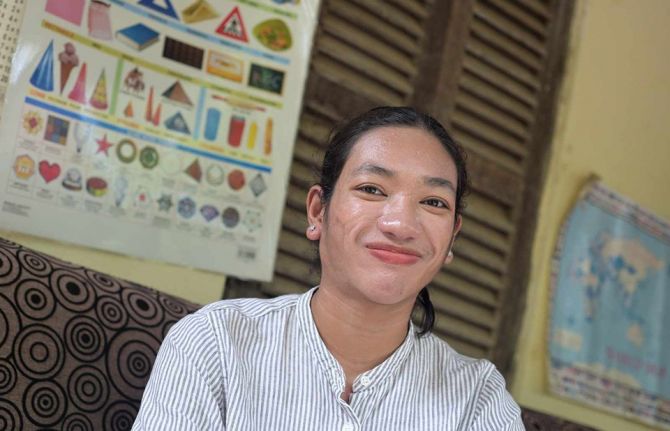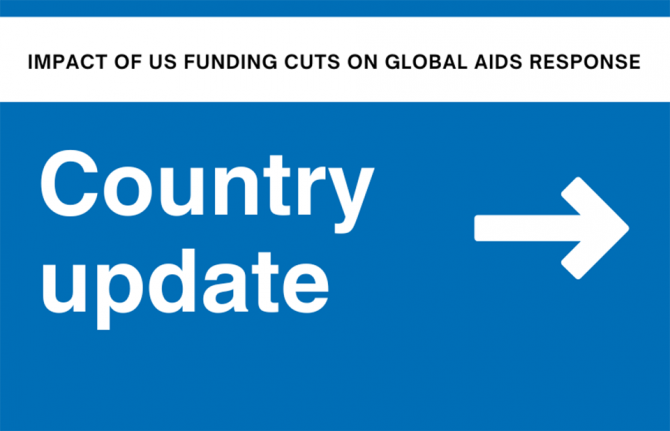
Feature Story
A national campaign aims to increase Namibian men's involvement in HIV health programmes
11 May 2011
11 May 2011 11 May 2011A version of this story was first published at www.unicef.org

Israel Ndeshaanya and Elisabeth Nagula, with their son, Nicolas.
Credit: UNICEF Namibia/2011/Manuel Moreno Gonzalez
Israel Ndeshaanya and Elisabeth Nagula live together with their 8-month old son, Nicolas, in Windhoek’s Katutura township.
Elisabeth is HIV-positive and Israel is very supportive of her, ensuring that she takes her antiretroviral drugs regularly. "Since the day she came to know about her status, I’ve never said any bad words to her...We are just as we have been.”
When Elisabeth became pregnant with Nicolas, the couple went through Namibia’s prevention of mother-to-child transmission of HIV programme. Nicolas was born free of the virus. The programme was started almost a decade ago and has been rolled out to 238 of 335 health facilities across the country, treating some 59 000 pregnant women every year.
Men’s participation
However, in Namibia, men who get involved like Mr Ndeshaanya are relatively rare. As with many other countries, men’s participation in health programmes tends to be lower than that of women.
Recent research conducted by UNICEF and the Namibian government shows that only about 3% of male partners of women in the national antenatal care programme took a HIV test in 2010, compared to 96% of women.
It is not enough for Namibian men to provide the basic necessities such as a house, food, water, electricity for their families. They should also become actively involved in health issues such as the prevention of HIV
President Pohamba
The research also shows that men have a direct bearing on their partner’s adherence to the prevention of mother-to-child transmission intervention, accessed through the antenatal care programme. In some cases they can actively work against the goals of the intervention by delaying access to care or withholding financial assistance.
By contrast, supportive men clearly have a positive effect. According to Ian MacLeod, UNICEF Representative in Namibia, to dramatically reduce new HIV infections among children, men’s participation is of critical importance, “A comprehensive response is needed, combining training of health workers, specialized infant feeding counsellors, community level support to breastfeeding mothers...and, very importantly, mothers need the support of their husbands or partners."
New target
This fact is something that Namibian First Lady Penehupifo Pohamba aims to promote through her new campaign to reduce HIV prevalence, which is supported by President Hifikepunye Pohamba, UNICEF and other organizations.
Launching the campaign, the President emphasized the vital role men play in caring for the well-being of their partners and children.
“It is not enough for Namibian men to provide the basic necessities such as a house, food, water, electricity for their families. They should also become actively involved in health issues such as the prevention of HIV,” he said.
President Hifikepunye Pohamba has set an ambitious target for Namibia to increase participation by men in voluntary HIV counselling and testing from 3% to 25% by the end of 2011.
In Namibia an estimated 13% of the adult population is living with the virus and nearly 20% of all pregnant women are reported to be HIV-positive.
Related

Feature Story
AIDS project helps communities in Russia to take actions to protect themselves
10 May 2011
10 May 2011 10 May 2011
From left: Jean-Louis lamboray, Director of The Constellation, one of the facilitators of the AIDS Competence project; Sveta Izambaeva, Niayaz Illiasovich Galiullin, Chief Doctor of the Kazan’s AIDS Center; Dr Denis Broun, Director of UNAIDS Regional Support Team for Europe
"You should not expect a solution to come from the outside. You need to look for it in the very communities and their people,” says the director of the international non-governmental organization The Constellation, Jean-Louis Lamboray during a recent presentation of the AIDS Competence project, in Kazan, Russia.
The objective of this initiative is to mobilize local responses to AIDS by promoting awareness within communities of their own strengths and capacities and facilitating the exchange of experiences within the communities. To accomplish this objective, the AIDS Competence project uses an approach called SALT— Stimulate, Acknowledge, Listen and Transfer—where trained facilitators visit communities to help them identify needs, formulate ideas and to form a leadership team from representatives of the community.
“People have enough wisdom and understanding of the risks. Our challenge is to encourage them to respond to the epidemic. Many communities and people are scattered and we have to help them form the right connections and networks,” added Mr Lamboray.
You should not expect a solution to come from the outside. You need to look for it in the very communities and their people
Jean-Louis Lamboray, Director of the international NGO The Constellation
The meetings between communities and facilitators in Kazan show that when, a community openly acknowledges the risk of HIV, it can take action and mobilize support from within.
“I am a mother and grandmother,” said Irina, who took part in the meeting. “I worry about my family and want to know what I can do to protect them from HIV."
"If we want to get rid of stigma, we have to start from small groups, at home, at work,” said Natalia, whose husband Sergei uses drugs and is HIV positive. “Let’s have a discussion about it with the families in our neighborhood.”
AIDS response in the Russian Federation
Eastern Europe remains the only region in the world where the epidemic is still on the rise. According to the Federal AIDS Centre in Russia, there are about 160 new registered cases of HIV infection daily in the country and more than 590,000 people are living with HIV. HIV transmission in the country is mainly driven by injecting drug use but heterosexual transmission is on the rise.
“The mobilization of the local response is critical for keeping the HIV epidemic under control in Russia as the lack of funding for HIV prevention programmes at the federal level may cause a serious setback in results achieved in the AIDS response,” said Dr Denis Broun, Director, UNAIDS Regional Support Team for Europe and Central Asia.
UNAIDS seeks to encourage community activism in the country and so it concentrates its advocacy work at decentralized levels for example by linking municipal authorities and civil society groups to help them share experiences and consolidate best practices around HIV prevention.
External links
External links
Related

Feature Story
Local African community organizations in Brussels bring attention to children orphaned by AIDS globally
09 May 2011
09 May 2011 09 May 2011
According to UNAIDS, there are 16.6 million children worldwide that have lost one or both parents to AIDS-related illnesses, almost 15 million of them live in the sub-Saharan Africa region.
Credit: WB/ C.Carnemark.
On 5 May, the External cooperation office of the European Commission provided a platform for representatives of self-support organizations for people affected by HIV from the African migrant community in Brussels to present on the situation of children orphaned by AIDS and other vulnerable children.
Organized by community organizations in collaboration with the Joint United Nations Programme on HIV/AIDS (UNAIDS) and the European Commission, the session brought together officials from the European Union (EU) institutions, permanent representations of EU Member States, civil society and other EU stakeholders.
Speaking at the conference hosted by the European Commission, Loraine Mukazi, who was herself orphaned by AIDS, spoke up for the millions without voice, “Being an AIDS orphan is to become an adult very quickly, a parent for your own parents, a head of a family.” She added, ”Losing a parent is already difficult, losing a parent to AIDS even more so, as you are confronted with the denial, taboo, stigma and countless questions.”
While fewer people are becoming infected with HIV and fewer are dying from AIDS, the epidemic continues to leave behind a growing number of orphans. According to UNAIDS, there are 16.6 million children worldwide that have lost one or both parents to AIDS-related illnesses, almost 15 million of them live in the sub-Saharan Africa region.
Losing a parent is already difficult, losing a parent to AIDS even more so, as you are confronted with the denial, taboo, stigma and countless questions
Loraine Mukazi, who was orphaned by AIDS
In addition to the trauma of losing a parent, orphans are often subject to discrimination and may be less likely to receive healthcare, education and other needed services. In HIV-affected households lacking social protection or community support, food consumption can drop by 40% putting children at risk of hunger, malnutrition and stunted growth. Impoverished, and without support to educate and protect themselves, orphans and vulnerable children face increased risk of HIV infection.
One of UNAIDS goals outlined in its 2011-2015 strategy is to ensure that all households affected by HIV, including orphans and vulnerable children, are addressed in all national social protection strategies and have access to essential care and support.
Social protection programmes can effectively increase the nutritional, health and educational status of children and reduce their risk of abuse and exploitation, with long-term developmental benefits. Experts agree that child-sensitive social protection should focus on aspects of well-being that include providing adequate child and maternal nutrition; access to quality basic services for the poorest and most marginalized; supporting families and caregivers in their childcare role; addressing gender inequality; preventing discrimination and child abuse in and outside the home; reducing child labour; increasing caregivers’ access to employment or income generation; and preparing adolescents for their own livelihoods, taking account of their role as current and future workers and parents.
Henning Mikkelsen, UNAIDS Representative to the European Union, expressed the hope that the upcoming General Assembly High Level Meeting on AIDS will lead to better social protection for families affected by AIDS and break the vicious circle where orphans and other children become highly vulnerable to HIV.
External links
External Links
- échos Séropos (in French)
- World AIDS Orphan Day

Feature Story
UNESCO: Sexuality education for young people highly cost-effective
06 May 2011
06 May 2011 06 May 2011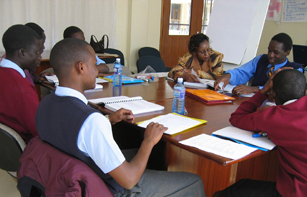
Students working with the Kenya government officials on sexuality education
Credit: UNESCO/Kenyan Centre for the Study of Adolescence
Sexuality education programmes can be highly cost-effective, especially when compulsory, adapted from existing models and integrated into the mainstream school curriculum. This is the major conclusion emerging from a seminal study released by UNESCO during a meeting of the UNAIDS Inter-Agency Task Team on Education in New York on 27 April 2011.
The study, Cost and cost-effectiveness: Analysis of school-based sexuality education programmes in six countries, examines a range of programmes in Estonia, India, Indonesia, Kenya, the Netherlands and Nigeria. It highlights significant cost savings in a number of settings. It also shows that compulsory programmes are more cost-effective as they reap the benefits and greater impact of full coverage of the student population.
For example, in Estonia a national sexuality education programme was introduced and linked with accessible, youth-friendly sexual and reproductive health services. Between 2001 and 2009 some 13 490 ‘health events’ were averted in the country, including nearly 2 000 HIV infections, at a potential lifetime cost of US$ 67 825 per patient, approximately 4 300 unintended pregnancies and more than 7 000 sexually transmitted infections.
We now have the data and analysis to make a stronger and better informed case for investing in school-based sexuality education programmes, particularly in those countries most affected by the epidemic and prioritized for attention in the new UNAIDS Strategy 2011-2015
Mark Richmond, UNESCO’s Global Coordinator for HIV and AIDS
The report also provides a detailed breakdown of the costs per learner of each completed sexuality education curriculum in the six countries. This ranges from US$ 6.90 in Nigeria to US$ 32.80 in the Netherlands. There are significantly higher costs in smaller pilot programmes, such as Kenya and Indonesia.
According to Mark Richmond, UNESCO’s Global Coordinator for HIV and AIDS, the landmark study gives an economic basis to the argument that sexuality education provides a key platform for HIV prevention amongst young people.
“We now have the data and analysis to make a stronger and better informed case for investing in school-based sexuality education programmes, particularly in those countries most affected by the epidemic and prioritized for attention in the new UNAIDS Strategy 2011-2015.”
Reducing the sexual transmission of HIV by half by 2015, including among young people, is one of the goals of the UNAIDS Strategy. However, the 2010 UNAIDS global report shows a critical gap in comprehensive prevention knowledge about HIV amongst this age group and that about 40% of all new HIV infections among adults occur among young people aged 15-24. Cost and cost-effectiveness adds to the growing recognition that school-based sexuality education has the potential to play a key role in improving young people’s knowledge for HIV prevention.
Inter-Agency Task Team on Education
Formed in 2002, the Inter-Agency Task Team on Education is convened by UNESCO and brings together UNAIDS Cosponsors, bilateral agencies, private donors and civil society partners to accelerate and improve a coordinated and harmonized education sector response to HIV.
External links
External links
Related
 “Who will protect our young people?”
“Who will protect our young people?”

02 June 2025

Feature Story
Condom march brings public and HIV prevention commissioners onto the streets in South Africa
06 May 2011
06 May 2011 06 May 2011
Treatment Action Campaign activists and UNAIDS HIV prevention commissioners march for scaled-up access to condoms.
Credit: UNAIDS/AFP Photo G. Guercia
A vibrant gathering took place outside the Treatment Action Campaign (TAC) in Site B in Khayelitsha on 4 May, as members of the public joined with high-level commissioners from the UNAIDS Commission on HIV Prevention to scale-up the use of condoms in communities most severely affected by HIV. Donning ‘HIV Positive’ t-shirts and dancing in unison to the music both on and off stage, Khayelitsha residents and others celebrated condoms as a barrier against the spread of the virus.
“Here in Khayelitsha, Treatment Action Coalition is empowering people living with HIV into leaders of the HIV prevention revolution,” said UNAIDS Executive Director Michel Sidibé, who also acknowledged the TAC’s role as a leading a “global movement for access to HIV treatment.”
Says TAC secretary-general, Vuyiseka Dubula, who is also a member of the UNAIDS Commission on HIV Prevention, “Our view at TAC is that condoms are by far the most effective tool to prevent HIV, and we have taken it upon ourselves team up with the City of Cape Town to increase accessibility.”
The partnership is now in its third year and, says Dubula, it has culminated in the distribution of at least one million condoms per annum in the region, with data from local clinics reporting an obvious drop in the incidence of sexual transmitting infections in the same period. But, she cautions, condom distribution needs to form part of a holistic approach to be most effective.
I was the first African president to report to the UN that my country was in trouble, and we became the first to give out antiretroviral therapy for free. I have come here to greet you and inspire you because we are one.
Former President of Botswana Festus G. Mogae
“We take condoms to people in their houses,” she explains. “We also consistently teach others about the correct use of condoms. We also bring supporting educational material in isiXhosa, we talk about the importance of testing, and we also share information about tuberculosis.”
An important figure at the gathering was a man known to most as either ‘Mr Condom’ or the ‘Condom King’. Hailing from Thailand, Mechai Viradaidya has been proactively distributing condoms for 37 years and, he says, his approach is all about the visibility of condoms—an approach that debunks the myths and gets rid of the taboo.
“Keep on mentioning condoms all the time, and let them be seen and be available everywhere,” he advises. “When I say they must be available, I don’t just mean physically, I mean mentally too. You have to have ‘condoms of the mind’ to really change behaviour.”
Viravaidya smiles and says he hands out condoms, “Absolutely everywhere except funerals.” He explains that he started bringing condoms out into the open in his native Thailand by having a condom-blowing competition amongst school teachers. “Whoever could blow the condom to the biggest size without it bursting was the winner,” he says.
He also set up the ‘cops and rubbers’ programme in Thailand by getting traffic police to sell and distribute condoms. He says that a condom is made of rubber like a tennis ball, “If you’re scared of condoms, be more scared of tennis balls—they contain a lot more rubber!”
Before TAC and the commissioners headed off on their march and on their community condom demonstrations, the crowd was treated to some words of wisdom from former President of Botswana Festus G. Mogae.
“I was the first African president to report to the UN that my country was in trouble,” he told those gathered. “We became the first to give out antiretroviral therapy for free. I have come here to greet you and inspire you because we are one.” He said that he had not come to preach but rather to ask everyone to carry on campaigning ‘until we win’.
“We will overcome,” he said to loud applause. “We need to all make it our business to ensure that no babies are born HIV positive. It is in our power to stop that from happening.”
UNAIDS Executive Director Mr Sidibé highlighted the significance of the event: “Today’s condom march shows that people with HIV are essential partners in movement for Positive Health, Dignity and Prevention.”
The condom march in Khayelitsha was part of a three-day programme convened by the UNAIDS High Level Commission on HIV Prevention in the Mother City. Other events included a panel discussion on social media and mobile technology in the prevention of HIV, and an historical gathering on Robben Island the following day where Desmond Tutu symbolically passed the baton of HIV activism to a group of youth leaders who, he hoped, would join him in stopping the spread of HIV.
External links
External links
Related

Feature Story
HIV prevention in action: Grassroot Soccer mobilizes young people to stop the spread of HIV
05 May 2011
05 May 2011 05 May 2011
UNAIDS Executive Director Michel Sidibé poses for a team photo with the young people taking part in the Skillz Street practice session at the Football for Hope Centre. Capetown, 4 May 2011.
Credit: UNAIDS/AFP Photo G. Guercia
During the meeting of the UNAIDS High Level Commission on HIV Prevention, which is taking place in South Africa this week, commissioners took time out to visit the Grassroot Soccer initiative in Capetown.
The commissioners visited the Football for Hope Centre during a Skillz Street practice session involving around 100 girls. Grassroot Soccer uses the power of soccer to educate, inspire, and mobilize communities to stop the spread of HIV. It builds basic life skills that help boys and girls adopt healthy behaviours and live risk-free.
UNAIDS Executive Director Michel Sidibé thoroughly enjoyed getting a chance to play football with the girls and was struck by the impact the centre is having on the community. “Here in Khayelitsha, the Football Centre for Hope is not just a project. It is a social meeting point for girls to protect themselves from HIV and become tomorrow’s football stars,” he said.
“Grassroot Soccer is restoring dignity and building self-esteem of young girls living in a challenging environment, transforming them into actors for the HIV prevention revolution.”
Grassroot Soccer is restoring dignity and building self-esteem of young girls living in a challenging environment, transforming them into actors for the HIV prevention revolution.
Michel Sidibé, UNAIDS Executive Director
The delegation also had a chance to interact with the local staff and coaches to hear about how the programme and curriculum work, as well as the other types of HIV prevention and testing interventions they run in the community.
UNAIDS partnered with Grassroot Soccer in the development of the Skillz Curriculum which includes interactive activities for young people to learn about HIV and get a chance to practice the skills necessary for sustainable behaviour change. Topics in the curriculum include making healthy decisions, avoiding risks, building support networks, reducing stigma and discrimination, increasing knowledge about testing and treatment, addressing gender issues, and assessing values. Each of the commissioners received a set of Skillz Magazines and Skillz Coaches Training DVD.
In 2002 Tommy Clark, the founder and CEO, started Grassroot Soccer with friends who had played professional soccer together in Zimbabwe. They instinctively knew that soccer represented an opportunity in the fight against HIV. The organization has been operating in South Africa since 2006.
Learn more about Grassroot Soccer in this brief video overview:
External links
External links
Related

Press Release
Archbishop Tutu passes baton to a new generation of leaders in the AIDS response
04 May 2011 04 May 2011Commitments made to transform the response to HIV at historic event on Robben Island

From left: Archbishop Desmond Tutu; Michel Sidibé, UNAIDS Executive Director; Dr Aaron Motsoaledi, South Africa Minister of Health.
Credit: UNAIDS/AFP Photo G. Guercia
Robben Island/Geneva, 4 May 2011—Archbishop Desmond Tutu has symbolically passed the baton to a new generation of young leaders focused on AIDS. The handover took place during an event held to inspire a transformation of the AIDS response which was convened by the Joint United Nations Programme on HIV/AIDS (UNAIDS) on Robben Island in South Africa.
The event joined together world renowned leaders from the UNAIDS High Level Commission on HIV Prevention with a group of young leaders who, in turn, presented the commissioners with a ‘call to action’ articulating the vision of the youth movement on HIV. The Commission on HIV Prevention was established by UNAIDS in 2010 to influence and lead social and political action aimed at galvanizing support for effective HIV prevention programmes.
“Today is about putting our heads and our hearts together to support a renewal of leadership and commitment in HIV prevention,” said Archbishop Tutu, co-chair of the Commission on HIV and long-standing AIDS advocate. “Bold and honest actions are needed and we look to the next generation of leaders to bring about positive change in attitudes and actions.”
The youth representatives convened recently in Mali at a youth leader’s summit on HIV where young people from across the world worked to find innovative ways of strengthening the links between youth and AIDS movements, notably through new media channels.
“Young people have the power to change the future and transform the AIDS response,” said Michel Sidibé, Executive Director of UNAIDS. “A collective youth movement mobilised around HIV prevention which exchanges important information through new technologies and peer education will stop new infections.”
Archbishop Tutu called on the young participants to commit to taking forward a new generation of leadership in the AIDS response. He also called on the HIV Prevention Commission members to inspire and mentor them in their leadership role.
Commitments were also made by the Commissioners who pledged to take the transformation of the AIDS response forward in their respective sectors. Commissioner Earvin “Magic” Johnson announced by video message that his Foundation will be a founding partner of a global foundations fellowship programme for young people. Elena Pinchuk’s AntiAIDS Foundation announced a global competition for young innovators to develop social networking campaigns. The Global centre for innovation in mobile health and Cell Life pledged to work together with UNAIDS and mobile service providers to promote HIV prevention and behaviour change dialogue through the use of mobile phones in at least five countries.
The event was held on Robben Island off the coast of Cape Town in South Africa where former president Nelson Mandela was incarcerated. The location is seen as a testimony to the human spirit, symbolising the power of change.
Contact
UNAIDS JohannesburgBathsheba Okwenje
tel. +27 82 909 2638
okwenjeb@unaids.org
UNAIDS Geneva
Sophie Barton-Knott
tel. +41 22 791 1697
bartonknotts@unaids.org
Press centre
Download the printable version (PDF)

Feature Story
Life Ball to raise awareness on overcoming stigma and discrimination against people living with and affected by HIV
03 May 2011
03 May 2011 03 May 2011
In the lead up to the 2011 Life Ball, UNAIDS participated in a kick off press conference in Vienna. This year’s Life Ball them is focused on the element of “Air”, following the quadrennial cycle of the four elements started in 2008.
The event will be held at Vienna’s landmark City Hall and more than 40 000 people are expected to attend. Focusing on Eastern Europe, the Life Ball hopes to raise awareness on such issues as overcoming stigma and discrimination against people living with and affected by HIV.
Mariangela Bavicchi-Lerner, Chief Resource Mobilization, participated on behalf of the UNAIDS alongside Gery Keszler, CEO of the Life Ball and Chairman of AIDS LIFE—the organization that produces the event. Fashion designers Dean and Dan Caten, of DSquared2 were also in attendance. The 2011 AIDS Solidarity Gala and Life Ball will take place on 21 May 2011.
External links
External links
Related

Feature Story
Preventing HIV with social media and mobile phones
02 May 2011
02 May 2011 02 May 2011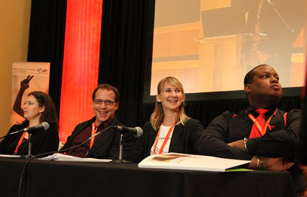
Panel on Social media and HIV prevention from left: Ms Helen Alexander, Sonke Gender Justice Network, Mr Richard Delate, The Johns Hopkins Health and Education in South Africa, Olga Rudnieva, Elena Pinchuk ANTIAIDS Foundation and Mr Ian Royer, What about HIV? Campaign. 2 May 2011.
Credit: Stefan Els, Stellenbosch University.
With more than 7 000 people newly infected with HIV everyday and 1 000 of these new infections occurring in South Africa, Stellenbosch University just outside Cape Town, was the ideal setting of a high level panel discussion on how social media and mobile technology has been and can be leveraged to prevent new HIV infections.
“The potential of new technologies to re-energize the AIDS-movement is clear. We need nothing less than an HIV prevention revolution, with social media and mobile technology at its core,” said Michel Sidibé, Executive Director of UNAIDS in his opening remarks.
Two panels one—on social media one on mobile technology—were livestreamed via the UNAIDS page on Facebook. The discussions brought together technology leaders, AIDS activists, and social media experts to share ideas of how these new tools can be integrated as part and parcel of HIV prevention programmes.
Mobilizing social networks for HIV and young people
During the social media session, a work in progress project was presented by Mr Ian Royer, a delegate at the recent Global Youth Summit on HIV in Mali. Participants at the summit launched a collaborative social media campaign together with an outcome document aimed at mobilizing youth organizations and networks globally to endorse the summit’s call to action. The website www.whatabouthiv.org is the hub of this initiative.
“So far we have had more than 1 000 endorsements and engaged more than 7 000 people from all around the world. Social media is an ideal tool to mobilize young people,” said Mr Royer. “We are scaling up our effort in the lead up to the High Level Meeting on AIDS in June to make sure that our call to action is heard loud and clear!”
With social media being all about two way conversations, the panelists took questions from Twitter and Facebook posed by people following the discussion online. Tweeter @baruchdom made the following comment: “Remember that the majority of Sex Workers and Drug Users and trans people don't have access to internet or social networking.”
A reply came from panelist Helen Alexander, with the Sonke Gender Justice Network: “In South Africa at least, the cell phone is an important tool of the trade for sex workers, as it helps them connect to their clients, and helps to keep them safe. So mobile phones are actually a great way to reach sex workers. It’s anonymous, you don’t have to track people down, and often these are people who are not comfortable coming to a community event,” said Ms Alexander.
Mobile platforms for social change
There are 500 million cell phones in Africa, and mHealth or mobile health is increasingly recognized as an effective channel for HIV programming.
We need nothing less than an HIV prevention revolution, with social media and mobile technology at its core
Michel Sidibé, UNAIDS Executive Director
“How can we begin to maximize the use of mobile technology for HIV prevention?” asked Marlon Parker Founder of Reconstructed Living Lab, a South African social enterprise. “We have to use this technology to educate, engage and empower people—and we can take this beyond the platforms to offline action!”
Ms Debbie Rogers, Lead Strategist of Praekelt Foundation, shared lessons learned from their free mobile platform Young Africa Live, which among other things aims to prevent new HIV infections in South Africa. According to Ms Rogers, the platform has reached 32 million page views and more than 950,000 comments posted since its launch.
App-development competition for HIV prevention launched
The internet and social media are widely used by young people everywhere—including low income countries. These tools have the potential to deliver HIV prevention programmes in a cost-effective way to young people through a media that they are already using.
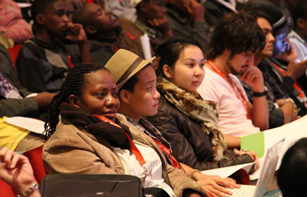
Participants at the social media and mobile technology for HIV prevention hosted at the Stellenbosch University, South Africa. 2 May, 2011.
Credit: Stefan Els, Stellenbosch University.
To move forward this agenda, Ms Olga Rudnieva, Executive Director, Elena Pinchuk ANTIAIDS Foundation, closed the event by announcing a competition for developing social media and/mobile applications for HIV prevention.
"By the end of the next week the criteria will be on the UNAIDS website. The challenge is to come up with a social network project with or without mobile applications to prevent HIV. We are welcoming projects up to USD 10 000. You have to be creative, innovative, do something good for you and for your community!” said Ms Rudnieva.
In the lead up to the High Level Meeting on AIDS, the social media and mobile technology for HIV prevention panels were co-hosted by UNAIDS and Stellenbosch University. It is part of UNAIDS strategy to inspire and catalyze young people to use social media to ignite an HIV prevention revolution.
External links
External links
Related

Feature Story
Qualitative study to tell the stories behind the numbers about women and HIV in Latin America
29 April 2011
29 April 2011 29 April 2011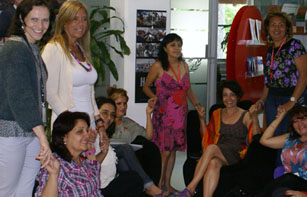
Some of the participants at the initial meeting to undertake a study on the “vulnerabilities of women living with HIV in Latin America and the Spanish speaking Caribbean”.
Women living with and affected by HIV in Latin America met recently in Panama to identify tools and methodologies to undertake their own study on the “vulnerabilities of women living with HIV in Latin America and the Spanish speaking Caribbean.”
The group of 20 women who took part are members of the Latin American and Caribbean Movement of Women Living with HIV (MLCM+) and they refuse to have their realities reflected only in graphs and numbers. Therefore, they have embarked on a qualitative investigation around the vulnerabilities and the diversity of women living with HIV in 13 countries in Latin America as well as Cuba.
“We want this qualitative study to tell the stories that numbers do not tell,” says Marcela Alsina, the Director of Movement of Women Living with HIV. “It’s a study by us and for us to demand policy change, funding and participation of women. We are tired of being objects of investigation for studies ending up on shelves. The success of this study depends on us. If we shelve the study, we shelve our life.”
The study will consist of three parts. First, there will be a mapping of the existing policies and legislation promoting and protecting women. The second part will take stock of women living with HIV participating in national AIDS responses. Finally in-depth interviews will be conducted with women living with HIV from different age groups and life situations including those at higher risk of infection such as migrant and displaced women, women in prisons and women using drugs. These interviews will establish the different conditions that make women vulnerable and exposed to HIV.
It’s a study by us and for us to demand policy change, funding and participation of women
Marcela Alsina, Director of Movement of Women Living with HIV
The study developed by MLCM+ is being supported by UNAIDS as part of the regional efforts to implement the Agenda for Accelerated Country Action for Women, Girls, Gender Equality and HIV which addresses the rights and needs of women and girls and highlights opportunities to work with networks of women living with HIV.
“This study will give us strategic information and evidence and make us the agents of change in our national responses,” said Gracia Violeta Ross from the Bolivian Network of People Living with HIV (REDBOL).
Ms Alsina is one of an estimated 550 000 women living with HIV in Latin America. There has been a reported increase in new HIV infections among women in the region. Participants at the meeting expressed the need to complement the current standards on HIV prevention which focus on the reduction of personal risk behaviours with approaches that seek to reduce vulnerabilities to HIV infection.
According to MLCM+ members, personal risk reduction approaches such as reducing the number of partners and increasing condom use are insufficient. The HIV response lacks programmes that reduce conditions of vulnerability to HIV among women, including poverty reduction, increased access to education for women, integrated sexual and reproductive health services, non-discriminatory services for HIV positive women and the elimination of gender-based violence in all its forms. Tackling these underlying conditions requires more long-term and integrated strategies.
“We need a movement for social justice, a place at the table to change the conditions that are creating the vulnerabilities of all women,” said Nadine Gasman, Director of the United Nations Secretary-Generals’ Campaign UNITE To End Violence Against Women which aims to prevent and eliminate violence against women and girls in all parts of the world.
The new UNAIDS Strategy 2011-2015 promotes zero tolerance of gender-based violence and discrimination. UNAIDS Regional Director César Núñez stressed the need to place women and men living with HIV at the centre of the AIDS response.

